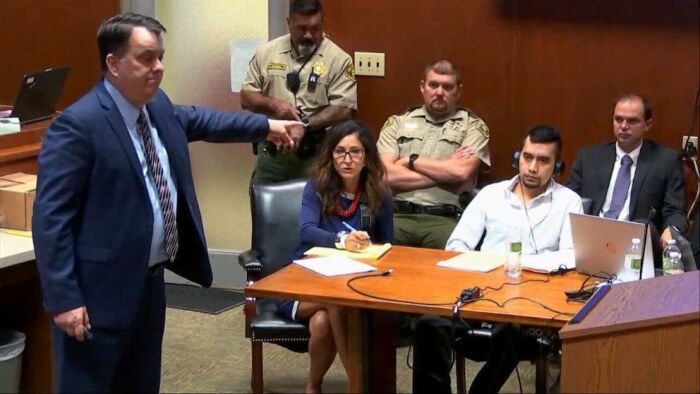Randy Evans is executive director of the Iowa Freedom of Information Council and can be reached at DMRevans2810@gmail.com.
Forty-four years ago, the Iowa Supreme Court made an important change in the way the state courts operate, by allowing journalists to bring their cameras and audio recorders inside courtrooms during hearings and trials to better inform the public about noteworthy cases.
Iowa was a pioneer in making its court proceedings more accessible and transparent to those who could not be there in person.
It is long overdue for the federal courts to follow Iowa’s lead and swing open the doors of federal courtrooms across the country to provide similar access. The coming proceedings in Florida in the case of United States of America vs. Donald J. Trump cry out for making this change.
Most court proceedings in Iowa and in the federal courts are open to spectators. But there rarely is space in the courtroom for more than an audience of a few dozen people.
Journalists historically have played an important role in Iowa as the intermediary for the public at large.
Instead of limiting reporters to using notepads and pens in court, the Iowa Judicial Branch allows what it calls “expanded news media coverage,” subject to approval from the presiding judge. Under this policy, journalists may use video and still-image cameras, audio recorders, laptop computers, and smart phones inside courtrooms.
Iowa’s court rules give the judge authority to block journalists from photographing or taping certain witnesses, such as minor children, the victims of sexual abuse, undercover police officers, or witnesses in criminal cases who fear for their safety. The court rules also prevent journalists from making photographs or video of the jurors.
Absent any of those concerns, allowing journalists to use their electronic gear inside courtrooms enables readers and viewers to have a fuller understanding of witnesses’ testimony and the exhibits each side presents to a jury.
Two trials in recent years illustrate the importance of this comprehensive coverage. There was live, gavel-to-gavel coverage by the Court TV cable news channel for police officer Derek Chauvin’s murder case in Minneapolis for the death of George Floyd, and for Brooklyn, Iowa, farmhand Cristhian Bahena Rivera’s trial for the abduction and killing of Iowa college student Molly Tibbetts.
The public was able to listen to the attorneys’ questions and hear the testimony of experts on whether Chauvin’s restraint technique prevented Floyd from breathing. Viewers could watch the testimony of detectives who were led by Rivera to the field where Tibbetts’ body was concealed. The public could see Rivera’s reaction.
Trump’s indictment on charges relating to possession of classified government documents has touched off bitter division across the country. Never before in U.S. history has a former president been charged with such crimes. Never has a candidate for president faced felony charges of such magnitude.
Whether you believe the former president is being railroaded or think he acted with reckless disregard for our nation’s security, allowing journalists to provide live coverage from inside the Miami courtroom where his case will be decided is essential if we hope to have public confidence in our government and in the fairness of our courts.
Prominent First Amendment attorney Floyd Abrams recently told the Washington Post columnist Jennifer Rubin,
There could hardly be any case in American history in which cameras in a courtroom could play a greater role in educating the public about the nature and fairness of a trial. The absence of cameras in the Miami courtroom in which a former president and likely future candidate for the presidency will be held would be an enormous public and historical loss.
Many reporters are skilled note-takers. But it is asking a lot to expect them to be able to scribble on a note pad the complex legal details, the nuances from the questions and the testimony—with no chance of replaying a certain passage or listening again to an important series of questions.
Mary Moriarty, a public defender in the Twin Cities for 30 years, said she had initially opposed televising the Chauvin trial. Afterward, though, her view had changed.
“I think it was important for people to see what happened, what the witnesses said, what the lawyers said, what the judge did, for the legitimacy of the process,” she told Minnesota Public Radio.
With so much at stake in the Trump case, everyone should hope the federal courts take steps to ensure the legitimacy of the pre-trial proceedings and trial. One way is for the judge to hold the courtroom door open for journalists’ television cameras, computers and recorders.
It has worked well in Iowa.
Top image: Prosecutor Scott Brown, an assistant Iowa attorney general, gestures toward defendant Cristhian Bahena Rivera during the 2021 trial of the rural Brooklyn man in the death of Molly Tibbetts, a University of Iowa student. Rivera was found guilty and is serving a life prison sentence. Photo from courtroom media pool.
Below: Courtroom in David W. Dyer Federal Building and U.S. Courthouse, Miami, Florida. Photograph from the Carol M. Highsmith Archive, Library of Congress; available via Wikimedia Commons.

